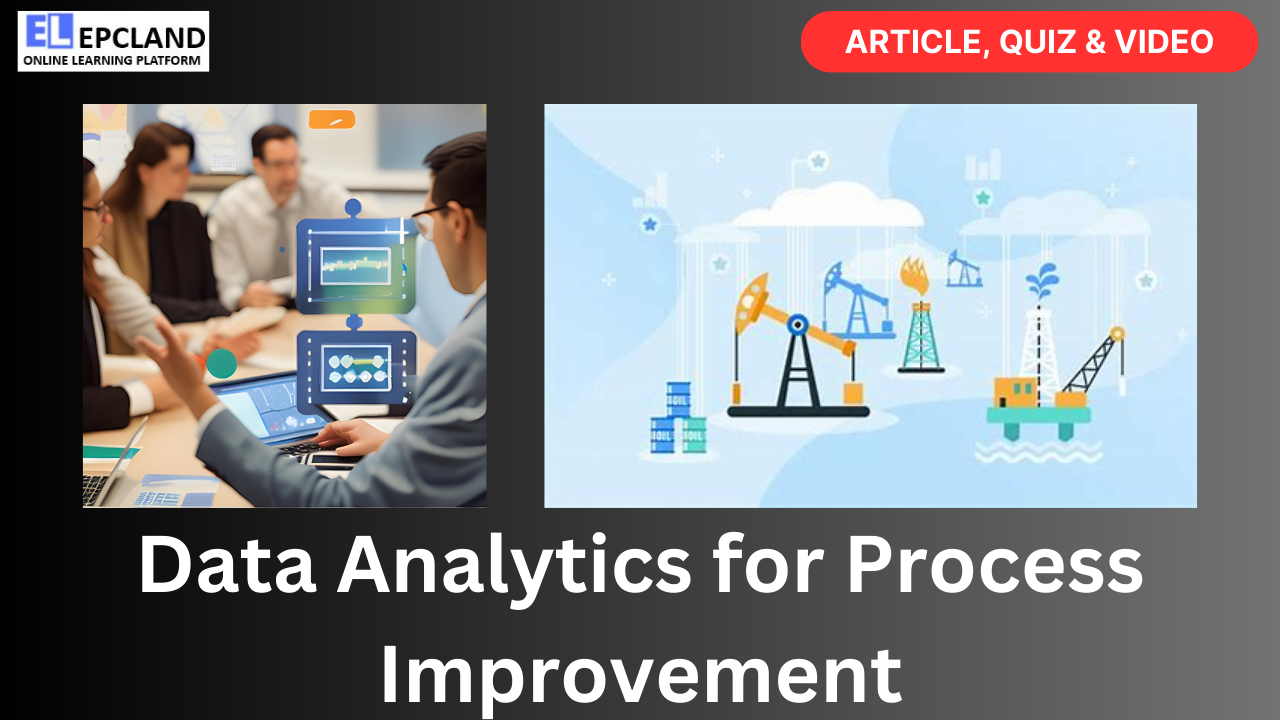Data Analytics for Process Improvement in Oil & Gas Industry Projects
Introduction
The Oil & Gas industry is known for its complexity and the multitude of processes involved, from exploration and drilling to refining and distribution. In this highly competitive and capital-intensive sector, the quest for efficiency, safety, and cost-effectiveness is ongoing. Data analytics has emerged as a powerful tool to drive process improvement and optimize operations. In this article, we will explore how data analytics is transforming the Oil & Gas industry, its applications in various processes, the advantages it offers, real-world case studies, and the future prospects of this technology.
Table of Contents
Understanding Data Analytics
What Is Data Analytics?
Data analytics is the process of examining large datasets to uncover hidden patterns, correlations, and insights. It involves the use of various techniques and tools to extract meaningful information from raw data. In the Oil & Gas industry, data analytics plays a crucial role in leveraging the vast amount of data generated at every stage of the value chain.
Applications in Oil & Gas Industry
Data analytics is applied across a wide spectrum of activities in the Oil & Gas sector, each contributing to process improvement and operational excellence:
1. Exploration and Reservoir Management
In the exploration phase, data analytics helps geologists and engineers analyze seismic data and geological formations to identify potential hydrocarbon reservoirs. Advanced algorithms can simulate reservoir behavior and estimate reserves more accurately. This aids in optimizing drilling locations and reducing exploration risks.
2. Drilling Optimization
Efficient drilling is vital for cost control and safety. Data analytics allows drilling engineers to monitor drilling parameters in real-time, predict equipment failures, and optimize drilling processes. By analyzing historical data and sensor readings, companies can identify trends and implement proactive maintenance strategies.
3. Predictive Maintenance
The Oil & Gas industry relies heavily on machinery and equipment. Data analytics enables predictive maintenance, where sensors continuously monitor equipment health and performance. This data is analyzed to predict when maintenance is needed, reducing downtime and avoiding costly breakdowns.
4. Production Optimization
Production facilities generate vast amounts of operational data. Data analytics helps operators monitor production in real-time, detect anomalies, and optimize processes for maximum output. By analyzing historical data, companies can make informed decisions on equipment upgrades and process improvements.
Do not miss the Complete Course on Piping Engineering
By EPCLand
5. Supply Chain Management
Efficient supply chain management is critical for timely delivery of resources and products. Data analytics provides visibility into the supply chain, optimizing inventory levels, reducing transportation costs, and ensuring the availability of critical components.
Advantages of Data Analytics
The adoption of data analytics in the Oil & Gas industry offers several advantages:
1. Improved Efficiency
Data analytics identifies inefficiencies and bottlenecks in processes, enabling companies to make data-driven decisions for optimization. This results in increased operational efficiency and reduced operational costs.
2. Enhanced Safety
Real-time monitoring and predictive analytics help identify potential safety hazards, allowing for immediate intervention to prevent accidents. Safer operations lead to reduced risks and liabilities.
3. Cost Reduction
Data-driven decisions lead to better resource allocation and reduced operational costs. Predictive maintenance prevents expensive equipment breakdowns, and optimized drilling reduces drilling time and expenses.
4. Environmental Responsibility
Data analytics supports environmental sustainability by helping companies monitor emissions, reduce waste, and implement more efficient and eco-friendly practices.
Case Studies
To illustrate the impact of data analytics in the Oil & Gas industry, let’s examine a few real-world case studies:
Case Study 1: Reservoir Simulation
A major oil company implemented a data analytics platform to analyze reservoir data collected from its offshore drilling sites. By running complex simulations and analyzing historical data, the company was able to increase reservoir recovery rates by 10%, resulting in millions of dollars in additional revenue.
Case Study 2: Predictive Maintenance
An oil refinery adopted a predictive maintenance system that utilized data analytics to monitor the condition of critical equipment. This led to a 30% reduction in maintenance costs and a 20% decrease in unplanned downtime.
Case Study 3: Real-time Production Optimization
A natural gas production facility implemented a real-time data analytics solution to monitor and optimize its production processes. By adjusting operational parameters based on real-time data analysis, the facility increased production efficiency by 15%.
Challenges and Solutions
While data analytics offers significant benefits, it comes with its own set of challenges in the Oil & Gas industry:
Data Quality and Integration
Challenge: The industry generates vast amounts of data from various sources, and ensuring data accuracy and integration can be challenging.
Solution: Implement data quality control processes and use data integration platforms to harmonize disparate data sources.
Data Security and Privacy
Challenge: Protecting sensitive data from cyber threats and ensuring compliance with data privacy regulations is a priority.
Solution: Invest in robust cybersecurity measures, encryption, and compliance frameworks to safeguard data.
Skilled Workforce
Challenge: Data analytics requires a skilled workforce with expertise in data science and domain knowledge.
Solution: Invest in employee training and development programs and collaborate with data analytics experts.
Future Trends
The future of data analytics in the Oil & Gas industry holds exciting possibilities:
1. Artificial Intelligence (AI) and Machine Learning (ML)
AI and ML algorithms will become more sophisticated, enabling better predictive analytics and autonomous decision-making in real-time.
2. Digital Twins
Digital twins, digital representations of physical assets, will become integral in monitoring and optimizing operations, from drilling rigs to refineries.
3. Edge Computing
Edge computing will enable real-time data analysis at the source, reducing latency and improving decision-making in remote locations.
Do not miss the Complete Course on Piping Engineering
By EPCLand
Conclusion
Data analytics has emerged as a powerful force for process improvement and operational excellence in the Oil & Gas industry. Its applications span exploration, drilling, production, supply chain management, and beyond. By leveraging data analytics, companies can enhance efficiency, improve safety, reduce costs, and demonstrate environmental responsibility.
As the industry evolves, data analytics will continue to play a pivotal role in shaping its future. With advancements in AI, ML, and edge computing, the Oil & Gas sector is poised to benefit from even more sophisticated data-driven insights, further solidifying its position as a leader in innovation and sustainability.
In an era where efficiency and sustainability are paramount, data analytics has become an indispensable tool for Oil & Gas industry players to thrive in an ever-evolving and competitive landscape.
FAQs
1. What is data analytics, and how does it apply to the Oil & Gas industry?
Answer: Data analytics is the process of examining large datasets to uncover patterns and insights. In the Oil & Gas industry, it applies by using data analysis techniques to optimize processes, enhance efficiency, and make informed decisions across various operations, from exploration to production and supply chain management.
2. What are the primary advantages of using data analytics in the Oil & Gas sector?
Answer: The primary advantages include improved operational efficiency, enhanced safety through real-time monitoring, cost reduction through predictive maintenance, and greater environmental responsibility through monitoring emissions and waste reduction.
3. What challenges does the Oil & Gas industry face when implementing data analytics, and how can they be addressed?
Answer: Challenges include data quality and integration issues, data security and privacy concerns, and the need for a skilled workforce. These challenges can be addressed by implementing data quality control processes, robust cybersecurity measures, and investing in employee training and development programs.
4. Can you provide examples of how data analytics has been used successfully in the industry?
Answer: Certainly! Examples include the use of data analytics to increase reservoir recovery rates, reduce maintenance costs through predictive maintenance, and improve production efficiency through real-time process optimization.
5. How is data security addressed when implementing data analytics in the Oil & Gas sector?
Answer: Data security is addressed through robust cybersecurity measures, encryption, and compliance frameworks. Companies also invest in secure data storage and transfer methods to protect sensitive information.
6. What are some future trends in data analytics for the Oil & Gas industry?
Answer: Future trends include the increasing use of artificial intelligence (AI) and machine learning (ML) for predictive analytics, the adoption of digital twins for asset monitoring, and the growth of edge computing for real-time data analysis.
7. How can data analytics contribute to environmental sustainability in the Oil & Gas industry?
Answer: Data analytics can contribute to sustainability by monitoring emissions, reducing waste, and optimizing processes to minimize environmental impact. This helps companies adhere to environmental regulations and demonstrate their commitment to responsible practices.
Recommended courses (Published on EPCLand)
- Basics of Piping Engineering
- Piping Layout Engineering
- Piping Material Engineering
- Piping Stress Analysis
- Complete Course on Piping Engineering
- Material Requisitions
- Piping Material Specifications
- Valve Material Specifications
Don’t miss the published articles on following:
Do not miss the Complete Course on Piping Engineering
By EPCLand
Related Video
Attempt Quiz
Question 1:
What is the primary goal of using data analytics in oil & gas projects?
Explanation: Data analytics in oil & gas projects primarily aims to improve safety, reliability, and operational efficiency.
Question 2:
Which type of data is often used for predictive maintenance in the oil & gas industry?
Explanation: Predictive maintenance in the oil & gas industry often relies on equipment sensor data to anticipate and prevent failures.
Question 3:
What is the term for using data analysis to optimize drilling operations?
Explanation: Using data analysis to optimize drilling operations is often referred to as “Drilling analytics.”
Question 4:
Which data visualization technique is commonly used in analyzing production data in the oil & gas sector?
Explanation: Decline curve analysis is a common data visualization technique used to analyze production data in the oil & gas sector.
Question 5:
What is the main advantage of using machine learning in reservoir management?
Explanation: The main advantage of using machine learning in reservoir management is the ability to predict reservoir behavior and optimize production.



